Contributions of Human Activities and Climatic Variability to Changes in River Rwizi Flows in Uganda, East Africa
Abstract
:1. Introduction
2. Materials and Methods
2.1. Study Area
2.2. Data
2.2.1. River Flow
2.2.2. Meteorological Series
2.2.3. Spatial Data
2.3. Methods
2.3.1. Analysis of the LULC Changes
2.3.2. SWAT Modeling and Quantification of Human Impacts
- I.
- Selection of rainfall series to use for modeling
- II.
- SWAT model build-up and sensitivity analysis
- III.
- SWAT model calibration and validation
- IV.
- Simulations and LULC change impacts
- (1)
- The optimal set of model parameters is kept constant during each simulation;
- (2)
- The same hydrometeorological series (such as rainfall and potential ET series) are used as model inputs over the given study period; and
- (3)
- There are no differences among the LULC maps (in other words, the spatial information from LULC maps for 2000, 2008, 2014, and 2019 are totally the same).
- V.
- Impacts of human activities and climate variability
- (a)
- As explained shortly above, the differences in the model results based on LULC map of 1997 and the simulations of LULC maps for 2000, 2008, 2014, and 2019 were taken to reflect the impacts of LULC changes on rainfall–runoff generation across the catchment.
- (b)
- To the differences in the means of the model results from (a), water diverted from the river through other human activities especially abstraction to supply several towns and industries within the catchment was added and the overall result was expressed as a percentage of the mean of observed flow.
- (c)
- The amount of total variance in river flow explained by the rainfall was computed. It is worth noting that rainfall–runoff generation is also controlled by other factors such as infiltration, percolation, and variation in evapotranspiration. Thus, if we assume that the model is perfect (or nearly so), the percentage of total variance in the observed flow explained by the simulated river flow indicates the influence of the other factors (like infiltration and percolation) and variation of climatic conditions (including changes in rainfall, temperature, and evapotranspiration) on rainfall–runoff generation.
- (d)
- The remaining percentage after deducting the total contribution from human activities (or LULC changes and river flow abstraction) and the percentage of the total river flow variance explained by the simulated flow (or an indicator of the influence of climate variability) was attributable to other factors such as reduced capacity of the hydrological model to capture complexities in rainfall–runoff generation processes, and possible flow returns into the river through discharge of effluents from industries.
2.3.3. Analysis of the Rainfall Variability
3. Results and Discussion
3.1. LULC Changes in Rwizi Catchment
3.2. SWAT Modeling
3.2.1. Correlation Analysis
3.2.2. SWAT Model Results
3.3. Possible Large-Scale Drivers of Rainfall Variability
3.4. Influence of Human Activities and Climate Variability
4. Conclusions
Author Contributions
Funding
Institutional Review Board Statement
Informed Consent Statement
Data Availability Statement
Acknowledgments
Conflicts of Interest
References
- Zhao, G.; Tian, P.; Mu, X.; Jiao, J.; Wang, F.; Gao, P. Quantifying the impact of climate variability and human activities on streamflow in the middle reaches of the Yellow River basin, China. J. Hydrol. 2014, 519, 387–398. [Google Scholar] [CrossRef]
- Wang, F.; Hessel, R.; Mu, X.; Maroulis, J.; Zhao, G.; Geissen, V.; Ritsema, C. Distinguishing the impacts of human activities and climate variability on runoff and sediment load change based on paired periods with similar weather conditions: A case in the Yan River, China. J. Hydrol. 2015, 527, 884–893. [Google Scholar] [CrossRef]
- Huang, H.; Han, Y.; Cao, M.; Song, J.; Xiao, H. Spatial-temporal variation of aridity index of China during 1960–2013. Adv. Meteorol. 2016, 2016, 1–10. [Google Scholar] [CrossRef]
- Pirnia, A.; Darabi, H.; Choubin, B.; Omidvar, E.; Onyutha, C.; Haghighi, A.T. Contribution of climatic variability and human activities to stream flow changes in the Haraz River basin, northern Iran. J. Hydro-Environ. Res. 2019, 25, 12–24. [Google Scholar] [CrossRef]
- Onyutha, C.; Willems, P. Investigation of flow-rainfall co-variation for catchments selected based on the two main sources of River Nile. Stoch. Environ. Res. Risk Assess. 2018, 32, 623–641. [Google Scholar] [CrossRef]
- Daily Monitor. How River Rwizi Destruction Has Left Mbarara in a Mess. Monday 13 June 2016. Available online: https://www.monitor.co.ug/uganda/lifestyle/reviews-profiles/how-river-rwizi-destruction-has-left-mbarara-in-a-mess-1654054 (accessed on 21 March 2021).
- Atwongyeire, D. Land Use Practices in the Rural and Urban Sub Catchments of River Rwizi, Western-Uganda; Their Effect on Its Ecological Characteristics. IJEES 2018, 3, 45. [Google Scholar] [CrossRef]
- Nagawa, G.; Atukunda, G.; Nuwabimpa, M.; Atwongyeire, D. Community perceptions towards the implications of human activity on River Rwizi. Int. J. Energy Environ. Sci. 2018, 6, 1–8. [Google Scholar]
- Pulitzer Center. Sucked Dry. Available online: https://pulitzercenter.org/stories/sucked-dry (accessed on 23 March 2021).
- The New Vision. River Rwizi Will Be History Soon-Locals. The New Vision, Uganda, Tuesday 10 September 2019. Available online: https://greenwatch.or.ug/sites/default/files/2019-10/River%20Rwizi%20will%20be%20history%20soon%20-%20locals.pdf (accessed on 23 March 2021).
- Mubialiwo, A.; Onyutha, C.; Abebe, A. Historical Rainfall and Evapotranspiration Changes over Mpologoma Catchment in Uganda. Adv. Meteorol. 2020, 2020, 8870935. [Google Scholar] [CrossRef]
- Onyutha, C.; Asiimwe, A.; Muhwezi, L.; Mubialiwo, A. Water availability trends across water management zones in Uganda. Atmos. Sci. Lett. 2021, e1095. [Google Scholar] [CrossRef]
- Ngoma, H.; Wen, W.; Ojara, M.; Ayugi, B. Assessing current and future spatiotemporal precipitation variability and trends over Uganda, East Africa, based on CHIRPS and regional climate model datasets. Meteorol. Atmos. Phys. 2021, 133, 823–843. [Google Scholar] [CrossRef]
- Jury, M.R. Uganda rainfall variability and prediction. Theor. Appl. Climatol. 2018, 132, 905–919. [Google Scholar] [CrossRef]
- Ssentongo, P.; Muwanguzi, A.J.B.; Eden, U.; Sauer, T.; Bwanga, G.; Kateregga, G.; Aribo, L.; Ojara, M.A.; Mugerwa, W.K.; Schiff, S.J. Changes in Ugandan Climate Rainfall at the Village and Forest Level. Sci. Rep. 2018, 8, 3551. [Google Scholar] [CrossRef]
- Onyutha, C.; Acayo, G.; Nyende, J. Analyses of Precipitation and Evapotranspiration Changes across the Lake Kyoga Basin in East Africa. Water 2020, 12, 1134. [Google Scholar] [CrossRef]
- Onyutha, C. Geospatial Trends and Decadal Anomalies in Extreme Rainfall over Uganda, East Africa. Adv. Meteorol. 2016, 2016, 6935912. [Google Scholar] [CrossRef] [Green Version]
- Onyutha, C. Trends and variability in African long-term precipitation. Stoch. Environ. Res. Risk Assess 2018, 32, 2721–2739. [Google Scholar] [CrossRef]
- Nicholson, S.E. Long-term variability of the East African ‘short rains’ and its links to large-scale factors. Int. J. Climatol. 2015, 35, 3979–3990. [Google Scholar] [CrossRef]
- Le, J.A.; El-Askary, H.M.; Allali, M.; Sayed, E.; Sweliem, H.; Piechota, T.C.; Struppa, D.C. Characterizing El Niño-Southern Oscillation Effects on the Blue Nile Yield and the Nile River Basin Precipitation using Empirical Mode Decomposition. Earth Syst. Environ. 2020, 4, 699–711. [Google Scholar] [CrossRef]
- Onyutha, C. Trends and variability of temperature and evaporation over the African continent: Relationships with precipitation. ATM 2021, 34, 267–287. [Google Scholar] [CrossRef]
- Onyutha, C. Analyses of rainfall extremes in East Africa based on observations from rain gauges and climate change simulations by CORDEX RCMs. Clim. Dyn. 2020, 54, 4841–4864. [Google Scholar] [CrossRef]
- Ministry of Water and Environment. State of Water Resources Basin Report for Victoria Water Management Zone (Analysis of Data into Information) Phase 1. Directorate of Water Resources Management Victoria Water Management Zone; Ministry of Water and Environment: Kampala, Uganda, 2017.
- Saha, S.; Moorthi, S.; Wu, X.; Wang, J.; Nadiga, S.; Thiaw, C.; Tripp, P.; Behringer, D.; Hou, Y.-T.; Chuang, H.-Y.; et al. The NCEP Climate Forecast System Version 2. J. Clim. 2014, 27, 2185–2208. [Google Scholar] [CrossRef]
- Kobayashi, S.; Ota, Y.; Harada, Y.; Ebita, A.; Moriya, M.; Onoda, H.; Onogi, K.; Kamahori, H.; Kobayashi, C.; Endo, H.; et al. The JRA-55 Reanalysis: General Specifications and Basic Characteristics. J. Meteorol. Soc. Jpn. 2015, 93, 5–48. [Google Scholar] [CrossRef] [Green Version]
- Funk, C.; Peterson, P.; Landsfeld, M.; Pedreros, D.; Verdin, J.; Shukla, S.; Husak, G.; Rowland, J.; Harrison, L.; Howll, A.; et al. The climate hazards infrared precipitation with stations—A new environmental record for monitoring extremes. Sci. Data 2015, 2, 150066. [Google Scholar] [CrossRef] [Green Version]
- Harris, I.; Osborn, T.J.; Jones, P.; Lister, D. Version 4 of the CRU TS monthly high-resolution gridded multivariate climate dataset. Sci. Data 2020, 7, 109. [Google Scholar] [CrossRef] [Green Version]
- Funk, C.; Nicholson, S.E.; Landsfeld, M.; Klotter, D.; Peterson, P.; Harrison, L. The Centennial Trends Greater Horn of Africa precipitation dataset. Sci. Data 2015, 2, 150050. [Google Scholar] [CrossRef]
- FAO-UNESCO. The Digital Soil Map of the World, Version 3.6; Land and Water Development Division, FAO: Rome, Italy, 2003. [Google Scholar]
- Neitsch, S.L.; Arnold, J.G.; Kiniry, J.R.; Williams, J.R.; King, K.W. Soil and Water Assessment Tool Theoretical Documentation; GSWRL 02-01 BRC 02-05 TR-01; USDA-ARS Publication; Blackland Research Center, Texas Agricultural Experiment Station: Temple, TX, USA, 2002. [Google Scholar]
- Abbaspour, K.C. SWAT-Calibration and Uncertainty Programs (CUP)—A User Manual; Swiss Federal Institute of Aquatic Science and Technology: Eawag, Duebendorf, 2015. [Google Scholar]
- Arnold, J.G.; Kiniry, J.R.; Srinivasan, R.; Williams, J.R.; Haney, E.B.; Neitsch, S.L. Soil & Water Assessment Tool: Input/Output Documentation, Version 2012; TR–439; Texas Water Resources Institute: Texas, TX, USA, 2012. [Google Scholar]
- Nash, J.E.; Sutcliffe, J.V. River flow forecasting through conceptual models part I—A discussion of principles. J. Hydrol. 1970, 10, 282–290. [Google Scholar] [CrossRef]
- Onyutha, C. From R-squared to coefficient of model accuracy for assessing ‘goodness-of-fits’. Geosci. Model Dev. Discuss. 2020, 1–25. [Google Scholar] [CrossRef]
- Milly, P.C.D.; Dunne, K.A. Macroscale water fluxes 2. Water and energy supply control of their interannual variability: Controls of Water Flux Variability. Water Resour. Res. 2002, 38, 241–249. [Google Scholar] [CrossRef] [Green Version]
- Sun, G.; McNulty, S.G.; Lu, J.; Amatya, D.M.; Liang, Y.; Kolka, R.K. Regional annual water yield from forest lands and its response to potential deforestation across the southeastern United States. J. Hydrol. 2005, 308, 258–268. [Google Scholar] [CrossRef]
- Talchabhadel, R.; Aryal, A.; Kawaike, K.; Yamanoi, K.; Nakagawa, H.; Bhatta, B.; Karki, S.; Thapa, B.R. Evaluation of precipitation elasticity using precipitation data from ground and satellite-based estimates and watershed modeling in Western Nepal. J. Hydrol. Reg. Stud. 2021, 33, 100768. [Google Scholar] [CrossRef]
- Chiew, F.H.S. Estimation of rainfall elasticity of streamflow in Australia. Hydrol. Sci. J. 2006, 51, 613–625. [Google Scholar] [CrossRef]
- Kumar, N.; Singh, S.K.; Singh, V.G.; Dzwairo, B. Investigation of impacts of land use/land cover change on water availability of Tons River Basin, Madhya Pradesh, India. Model. Earth Syst. Environ. 2018, 4, 295–310. [Google Scholar] [CrossRef]
- Gebrehiwot, S.G.; Seibert, J.; Gärdenäs, A.I.; Mellander, P.-E.; Bishop, K. Hydrological change detection using modeling: Half a century of runoff from four rivers in the Blue Nile Basin: Hydrological Change Detection Using Modeling. Water Resour. Res. 2013, 49, 3842–3851. [Google Scholar] [CrossRef] [Green Version]
- Rayner, N.A. Global analyses of sea surface temperature, sea ice, and night marine air temperature since the late nineteenth century. J. Geophys. Res. 2003, 108, 4407. [Google Scholar] [CrossRef]
- Trenberth, E.K. The Definition of El Niño. Bull. Am. Meteorol. Soc. 1997, 78, 2771–2778. [Google Scholar] [CrossRef] [Green Version]
- Onyutha, C. Statistical uncertainty in hydrometeorological trend analyses. Adv. Meteorol. 2016, 2016, 8701617. [Google Scholar] [CrossRef] [Green Version]
- Republic of Uganda. The Constitution of the Republic of Uganda; Ministry of Justice and Constitutional Affairs: Kampala, Uganda; Uganda Printing and Publishing Corporation: Entebbe, Uganda, 1995.
- Republic of Uganda. Guidelines on the Management of Land and other Related Issues under the Land Act, 1998; Ministry of Water, Lands and Environment, Government of Uganda: Kampala, Uganda, 1998.
- Republic of Uganda. Uganda: The Refugees Regulations, 2010, 27 October 2010, S.I. 2010 No. 9; Government of Uganda: Kampala, Uganda, 2010.
- Republic of Uganda. National Land Policy, 2013. National Legislative Bodies/National Authorities; Government of Uganda, Ministry of Water, Lands and Environment: Kampala, Uganda, 2013.
- Onyutha, C. Long-term climatic water availability trends and variability across the African continent. Theor. Appl. Climatol. 2021. [Google Scholar] [CrossRef]
- Bárdossy, A.; Singh, S.K. Robust estimation of hydrological model parameters. Hydrol. Earth Syst. Sci. 2008, 12, 1273–1283. [Google Scholar] [CrossRef] [Green Version]
- Goodwell, A.E.; Kumar, P. Temporal information partitioning: Characterizing synergy, uniqueness, and redundancy in interacting environmental variables. Water Resour. Res. 2017, 53, 5920–5942. [Google Scholar] [CrossRef]
- Gupta, H.V.; Nearing, G.S. Debates-the future of hydrological sciences: A (common) path forward? Using models and data to learn: A systems theoretic perspective on the future of hydrological science. Water Resour. Res. 2014, 50, 5351–5359. [Google Scholar] [CrossRef]
- Gharari, S.; Gupta, H.V.; Clark, M.P.; Hrachowitz, M.; Fenicia, F.; Matgen, P.; Savenije, H.H.G. Understanding the Information Content in the Hierarchy of Model Development Decisions: Learning from Data. Water Res. 2021, 57, e2020WR027948. [Google Scholar] [CrossRef]
- Onyutha, C.; Turyahabwe, C.; Kaweesa, P. Impacts of climate variability and changing land use/land cover on River Mpanga flows in Uganda, East Africa. Environ. Chall. 2021, 5, 100273. [Google Scholar] [CrossRef]
- Nyesigire, R. Quantitative Analysis of Contributions of Human Activities and Climatic Variability to Stream Flow Variation in River Rwizi Catchment. Master’s Thesis, Kyambogo University, Kampala, Uganda, 2021. [Google Scholar]

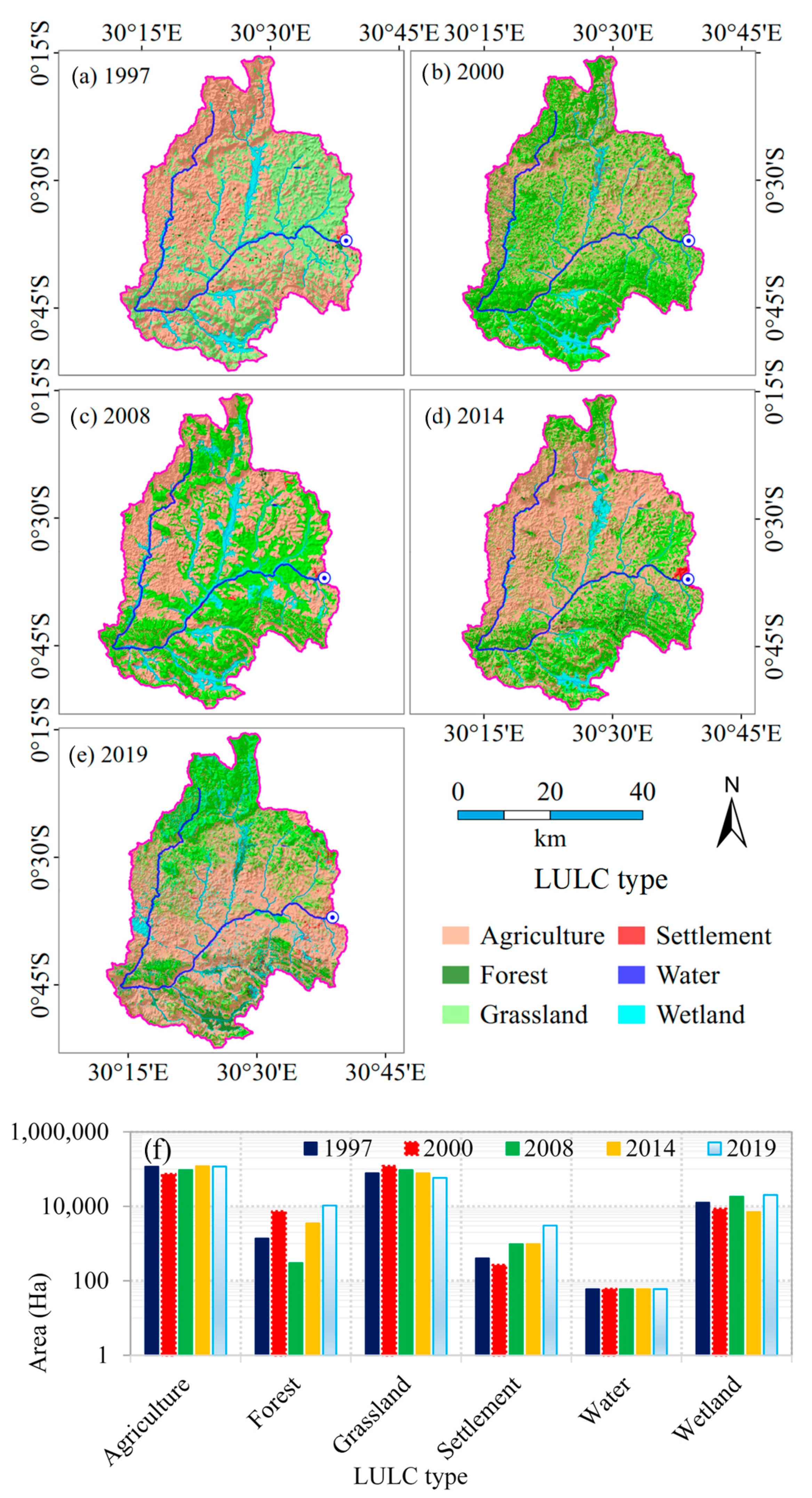

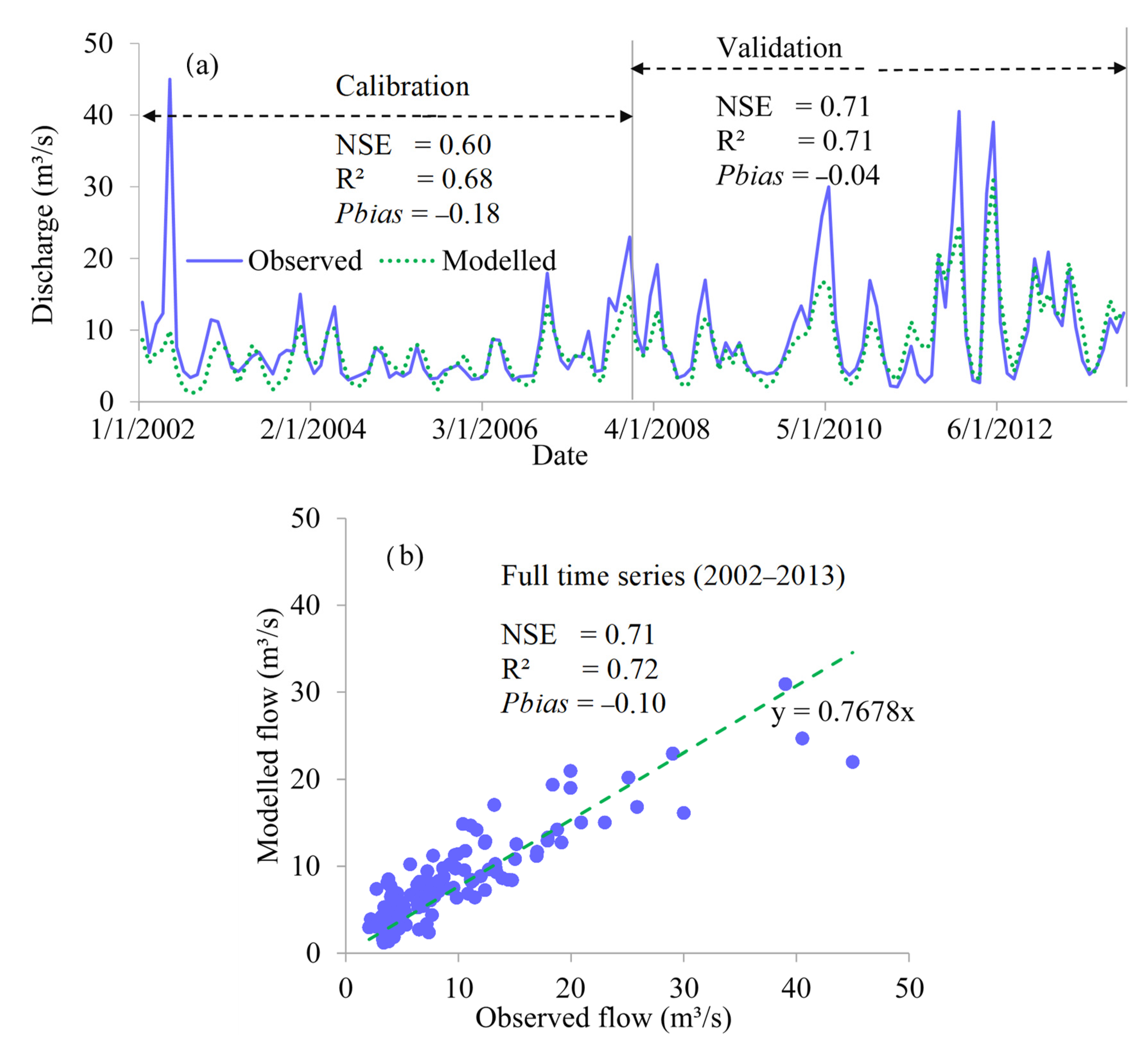
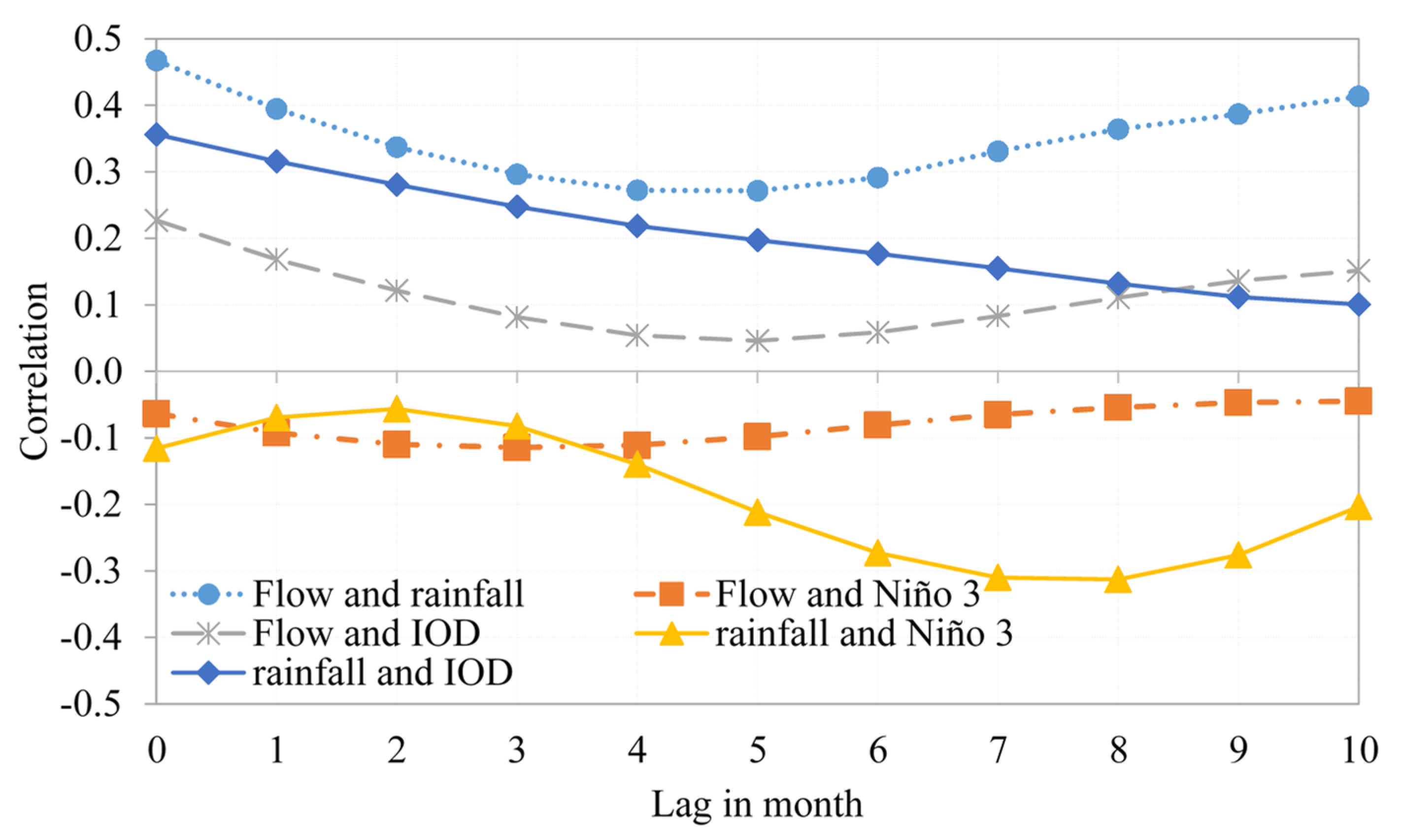
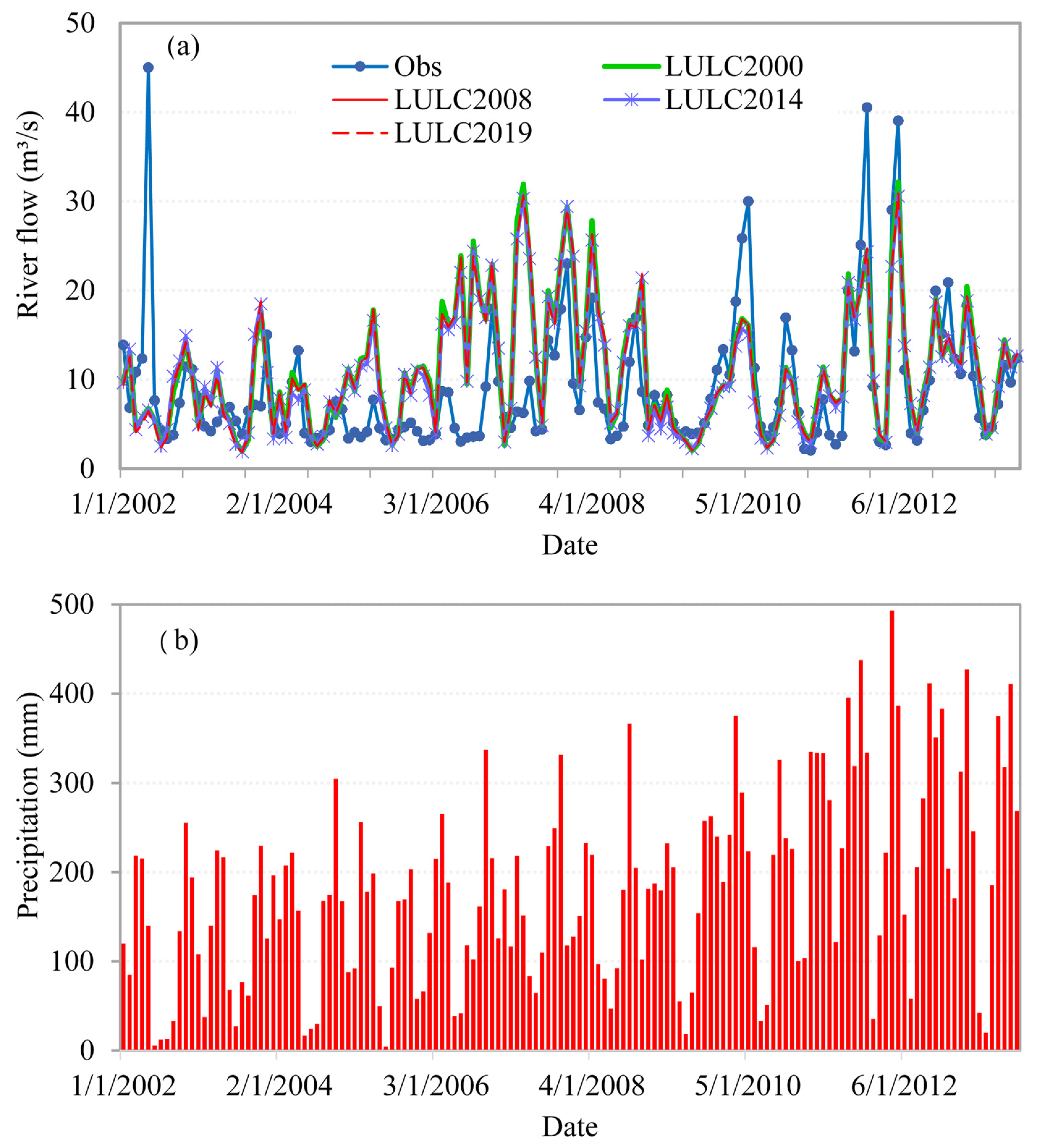
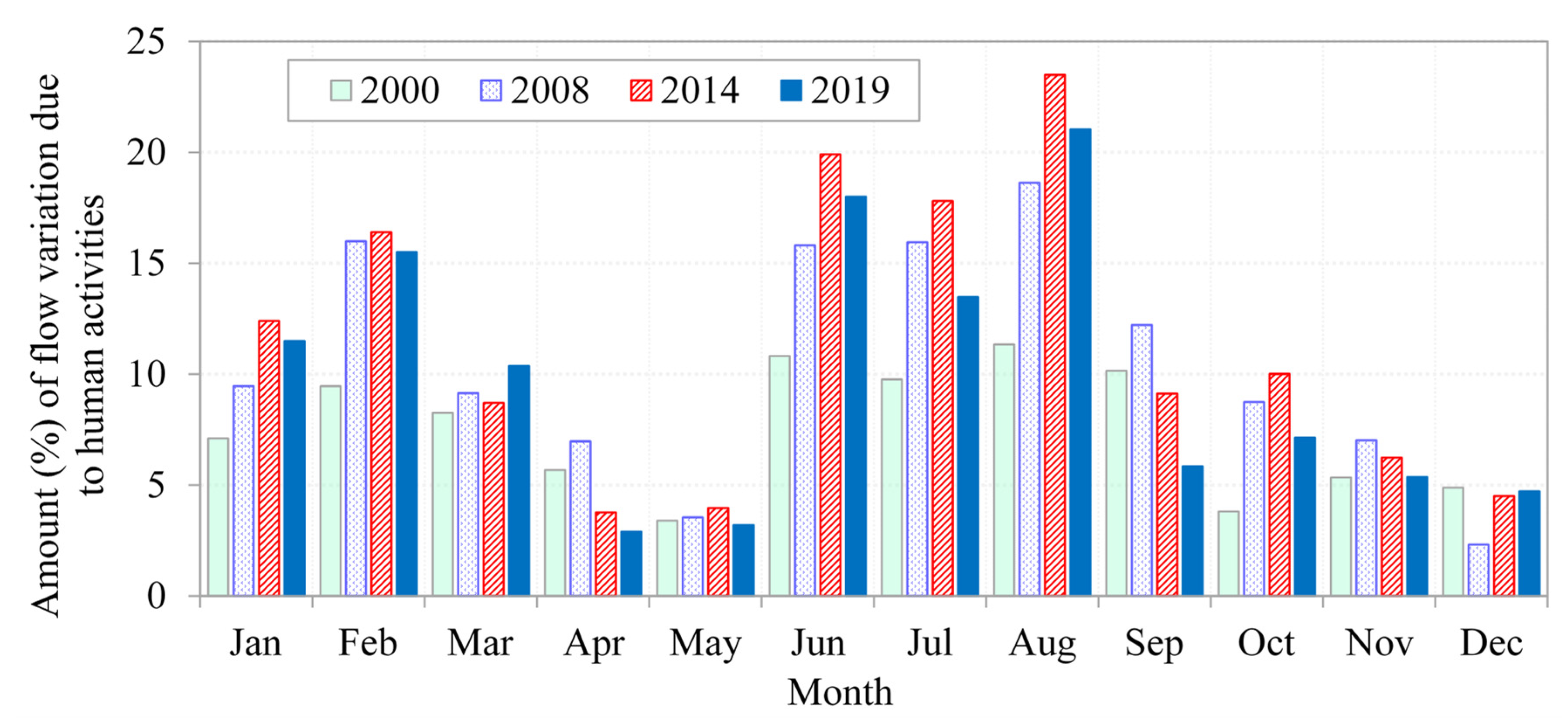
| LULC | Area (%) | ||||
|---|---|---|---|---|---|
| 1997 | 2000 | 2008 | 2014 | 2019 | |
| Cropland | 38.2 | 23.0 | 39.1 | 51.6 | 31.6 |
| Forest | 1.7 | 3.7 | 1.3 | 3.7 | 9.8 |
| Grassland | 54.7 | 63.3 | 52.3 | 37.8 | 36.6 |
| Settlement | 0.1 | 0.1 | 0.4 | 0.4 | 4.8 |
| Water | 1.8 | 1.8 | 1.7 | 1.7 | 1.6 |
| Wetland | 3.5 | 8.1 | 5.2 | 4.7 | 15.6 |
| LULC Type | Change in LULC Area (Ha) | |||
|---|---|---|---|---|
| 1997–2000 | 2000–2008 | 2008–2014 | 2014–2019 | |
| Cropland | −126,495 | 134,144 | 103,496 | −165,811 |
| Forest | 17,244 | −20,010 | 19,959 | 50,232 |
| Grassland | 71,322 | −91,235 | −120,202 | −10,468 |
| Settlement | −31 | 2222 | 266 | 35,939 |
| Water | −1034 | −3 | 709 | −533 |
| Wetland | 38,992 | −25,117 | −4229 | 90,641 |
| Data | Jan | Feb | March | April | May | June | July | Aug | Sept | Oct | Nov | Dec |
|---|---|---|---|---|---|---|---|---|---|---|---|---|
| No lag | ||||||||||||
| CFSR | 0.12 | 0.62 | 0.44 | 0.58 | 0.25 | 0.06 | −0.34 | 0.15 | 0.68 | 0.64 | 0.46 | 0.54 |
| CRU | −0.58 | −0.19 | −0.50 | −0.25 | −0.14 | −0.34 | −0.11 | 0.03 | −0.06 | 0.20 | 0.18 | 0.36 |
| CHIRPS | 0.23 | 0.45 | 0.61 | 0.31 | 0.60 | 0.33 | −0.13 | −0.15 | 0.76 | 0.18 | 0.27 | 0.22 |
| JRA55 | 0.01 | −0.06 | 0.16 | −0.08 | 0.25 | 0.04 | 0.00 | −0.22 | 0.35 | 0.26 | 0.01 | 0.00 |
| CenTrends | 0.14 | 0.48 | 0.38 | 0.50 | 0.16 | 0.51 | 0.15 | 0.18 | 0.30 | −0.13 | 0.24 | 0.29 |
| 1-month lag | ||||||||||||
| CFSR | 0.36 | 0.38 | −0.13 | 0.30 | −0.04 | 0.04 | −0.40 | 0.39 | 0.30 | 0.49 | 0.52 | −0.25 |
| CRU | −0.04 | −0.60 | −0.08 | −0.06 | −0.12 | −0.02 | −0.17 | −0.46 | −0.08 | 0.28 | 0.28 | −0.10 |
| CHIRPS | 0.11 | 0.44 | −0.47 | 0.13 | −0.22 | 0.28 | −0.68 | 0.34 | 0.20 | 0.21 | 0.26 | −0.31 |
| JRA55 | −0.24 | −0.15 | −0.20 | −0.13 | −0.04 | 0.26 | −0.41 | 0.14 | 0.23 | 0.10 | −0.35 | −0.33 |
| CenTrends | 0.22 | 0.35 | 0.09 | −0.23 | 0.27 | 0.37 | −0.06 | 0.70 | −0.05 | 0.07 | 0.08 | −0.38 |
| 2-month lag | ||||||||||||
| CFSR | 0.41 | 0.07 | −0.42 | 0.04 | −0.12 | −0.06 | −0.36 | 0.14 | 0.60 | 0.28 | −0.23 | −0.04 |
| CRU | −0.54 | 0.11 | −0.09 | 0.16 | 0.45 | 0.34 | −0.44 | −0.05 | −0.11 | 0.61 | −0.27 | 0.78 |
| CHIRPS | 0.42 | −0.30 | −0.42 | −0.04 | −0.10 | −0.37 | −0.34 | −0.34 | 0.34 | −0.12 | −0.14 | −0.07 |
| JRA55 | −0.14 | −0.03 | 0.15 | 0.03 | −0.17 | −0.46 | −0.36 | −0.13 | 0.11 | −0.65 | −0.25 | −0.11 |
| CenTrends | 0.21 | 0.22 | −0.03 | 0.55 | −0.22 | −0.27 | 0.15 | 0.09 | 0.10 | −0.15 | −0.28 | 0.06 |
| 3-month lag | ||||||||||||
| CFSR | 0.43 | −0.24 | −0.25 | −0.08 | −0.15 | 0.01 | −0.02 | 0.35 | 0.34 | −0.05 | 0.26 | 0.21 |
| CRU | 0.44 | 0.32 | −0.10 | 0.24 | 0.37 | 0.00 | 0.31 | 0.02 | 0.58 | −0.39 | 0.67 | 0.38 |
| CHIRPS | −0.02 | −0.47 | −0.08 | −0.24 | −0.42 | −0.21 | 0.14 | 0.39 | −0.14 | −0.16 | 0.16 | −0.56 |
| JRA55 | 0.14 | 0.04 | 0.25 | −0.37 | −0.35 | −0.23 | 0.25 | 0.21 | −0.35 | −0.22 | 0.18 | −0.22 |
| CenTrends | 0.40 | 0.04 | 0.10 | −0.16 | −0.47 | 0.01 | 0.56 | 0.13 | −0.03 | −0.34 | 0.26 | −0.26 |
| S/N | Parameter Name | Description | t-Stat | p-Value |
|---|---|---|---|---|
| 1 | v__ALPHA_BF | Base flow alpha factor (days) | 10.49 | 2.53 × 10−23 |
| 2 | v__HRU_SLP | Average slope steepness (m/m) | 6.43 | 3.00 × 10−10 |
| 3 | r__CN2 | Moisture condition II curve number | 5.11 | 4.49 × 10−7 |
| 4 | v__GWQMN | Threshold water level in shallow aquifer for base flow to occur (mm) | −4.49 | 9.00 × 10−6 |
| 5 | v__SOL_BD | Moist bulk density (g/cm3) | 4.074 | 5.40 × 10−5 |
| 6 | v__CH_K2 | Effective hydraulic conductivity of main channel alluvium (mm/hr) | −3.32 | 9.49 × 10−4 |
| 7 | v__SLSUBBSN | Average slope length (m) | −3.14 | 1.77 × 10−3 |
| 8 | r__SOL_AWC | Available water capacity of the soil layer (mm H2O/mm soil) | 2.48 | 1.34 × 10−2 |
| 9 | v__REVAPMN | Threshold depth of water in the shallow aquifer for percolation to the deep aquifer to occur (mm. H2O). | 1.65 | 9.82 × 10−1 |
| 10 | r__SOL_K | Saturated hydraulic conductivity (mm/h) | 1.62 | 1.06 × 10−1 |
| 11 | v__ESCO | Plant uptake compensation factor | 1.41 | 1.60 × 10−1 |
| 12 | r__GW_REVAP | Groundwater evapotranspiration coefficient | −1.24 | 2.13 × 10−1 |
| 13 | v__CH_N2 | Manning’s “n” value for the main channel | −0.93 | 3.55 × 10−1 |
Publisher’s Note: MDPI stays neutral with regard to jurisdictional claims in published maps and institutional affiliations. |
© 2021 by the authors. Licensee MDPI, Basel, Switzerland. This article is an open access article distributed under the terms and conditions of the Creative Commons Attribution (CC BY) license (https://creativecommons.org/licenses/by/4.0/).
Share and Cite
Onyutha, C.; Nyesigire, R.; Nakagiri, A. Contributions of Human Activities and Climatic Variability to Changes in River Rwizi Flows in Uganda, East Africa. Hydrology 2021, 8, 145. https://doi.org/10.3390/hydrology8040145
Onyutha C, Nyesigire R, Nakagiri A. Contributions of Human Activities and Climatic Variability to Changes in River Rwizi Flows in Uganda, East Africa. Hydrology. 2021; 8(4):145. https://doi.org/10.3390/hydrology8040145
Chicago/Turabian StyleOnyutha, Charles, Resty Nyesigire, and Anne Nakagiri. 2021. "Contributions of Human Activities and Climatic Variability to Changes in River Rwizi Flows in Uganda, East Africa" Hydrology 8, no. 4: 145. https://doi.org/10.3390/hydrology8040145






